Welcome, fellow nature enthusiasts, to a captivating journey through the enchanting world of the Montana State Insect: the mourning cloak butterfly.
In this article, you’ll uncover intriguing facts, unravel its mystique, and gain a deeper appreciation for this beautiful creature that graces the Big Sky Country.
You may wonder, what’s so special about the mourning cloak butterfly? Allow me to quell your curiosity.
As an avid nature lover, I’ve spent considerable time studying and researching these captivating creatures.
Whether you’re a budding lepidopterist or simply a curious soul seeking to unravel the wonders of the natural world, this article is for you.
- Related article: Montana State Emblems
From the cloak caterpillars’ intriguing journey of transformation to this official state butterfly’s role as one of the larger families of butterflies, we’ll delve into it all.
Montana State Insect: Mourning Cloak Butterfly
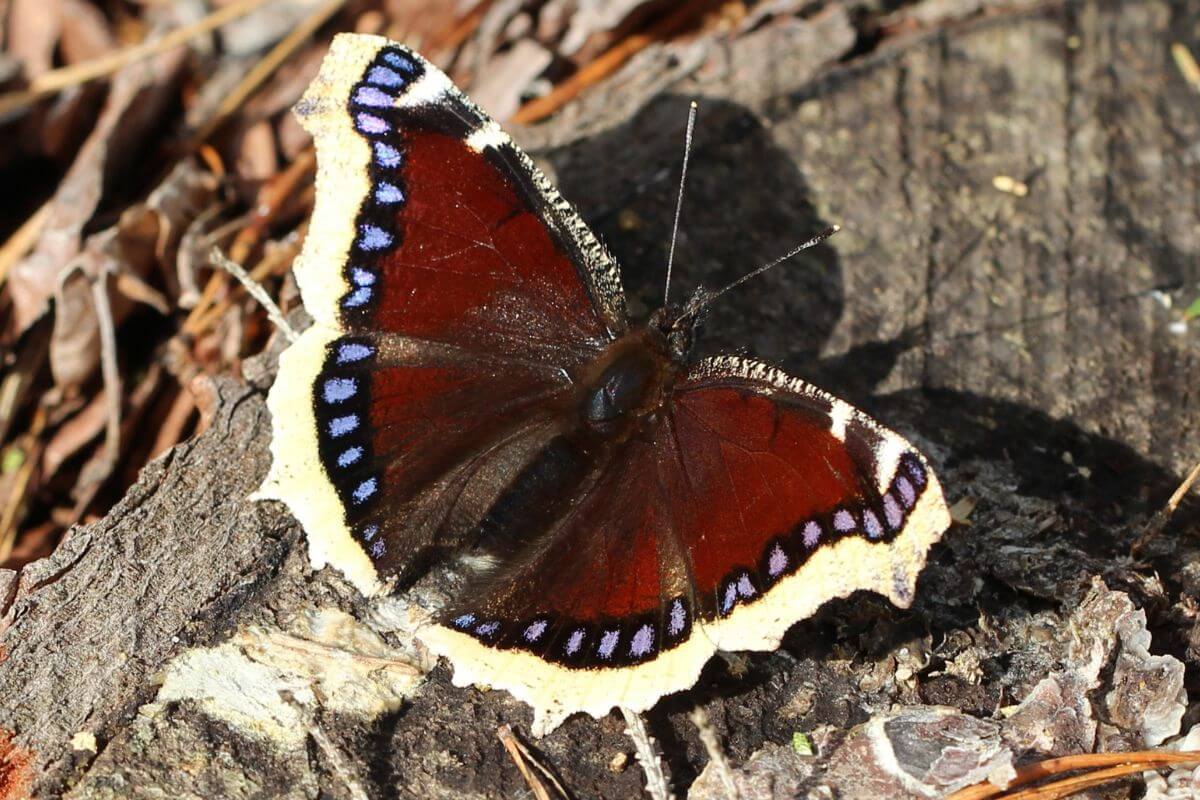
In 2001, House Bill No.65, primarily sponsored by James Whitaker, declared the mourning cloak butterfly as Montana’s official state insect.
This elegant creature, scientifically known as Nymphalis antiopa, possesses qualities that make it a fitting representative of the state.
With a wingspan ranging from 2 1/4 to 4 inches, the large size of this butterfly demands attention.
The upper wings of the mourning cloak butterfly are a deep, dark brown with an enchanting reflection of purple, adorned with captivating blue spot markings.
However, it is on the underside where its true camouflage capabilities shine.
The dark brown coloration provides an excellent disguise against tree bark, enabling this butterfly to blend seamlessly with its surroundings.
A stunning yellow border edges the mourning cloak butterfly’s wings, further accentuating its beauty.
Its overall dark coloring has earned it its common name, as it resembles a somber cloak worn by someone in mourning.
Additionally, mourning cloak butterflies are also known as “brush-footed butterflies” due to their small, hairy, and brush-like front pair of legs. This distinguished feature sets it apart from other butterfly species.
With this knowledge, you’re now equipped to venture out into nature and keep an eye out for this remarkable creature, whose elegance and charm reflect the breathtaking landscapes of the Big Sky Country.
Mourning Cloak Butterfly Life
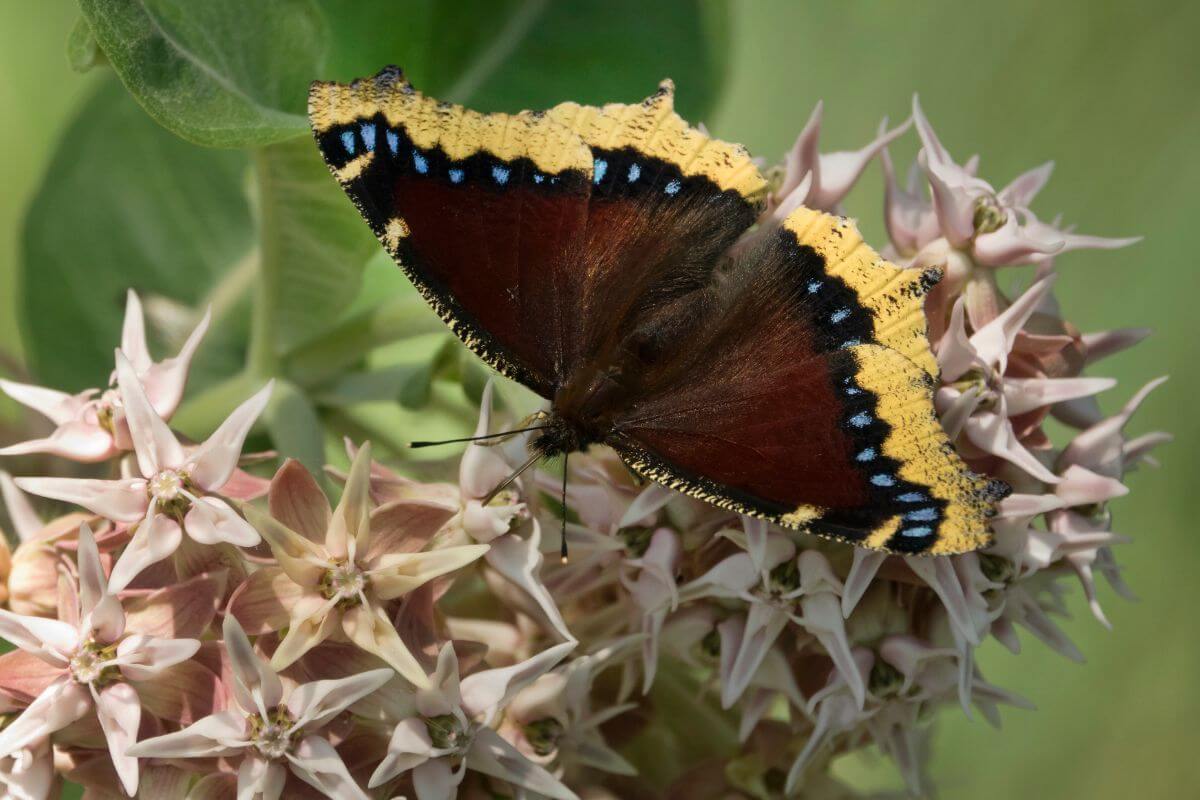
As I observe the intriguing life cycle of the mourning cloak butterfly, I am captivated by its unique mating and reproduction process.
Along with several seasons and temperature fluctuations, mourning butterflies emerge from their cocoons, spreading their vibrant wings to take flight and begin the cycle anew.
Let me walk you through their very interesting life cycle.
1. Mourning Cloak Butterfly Mating
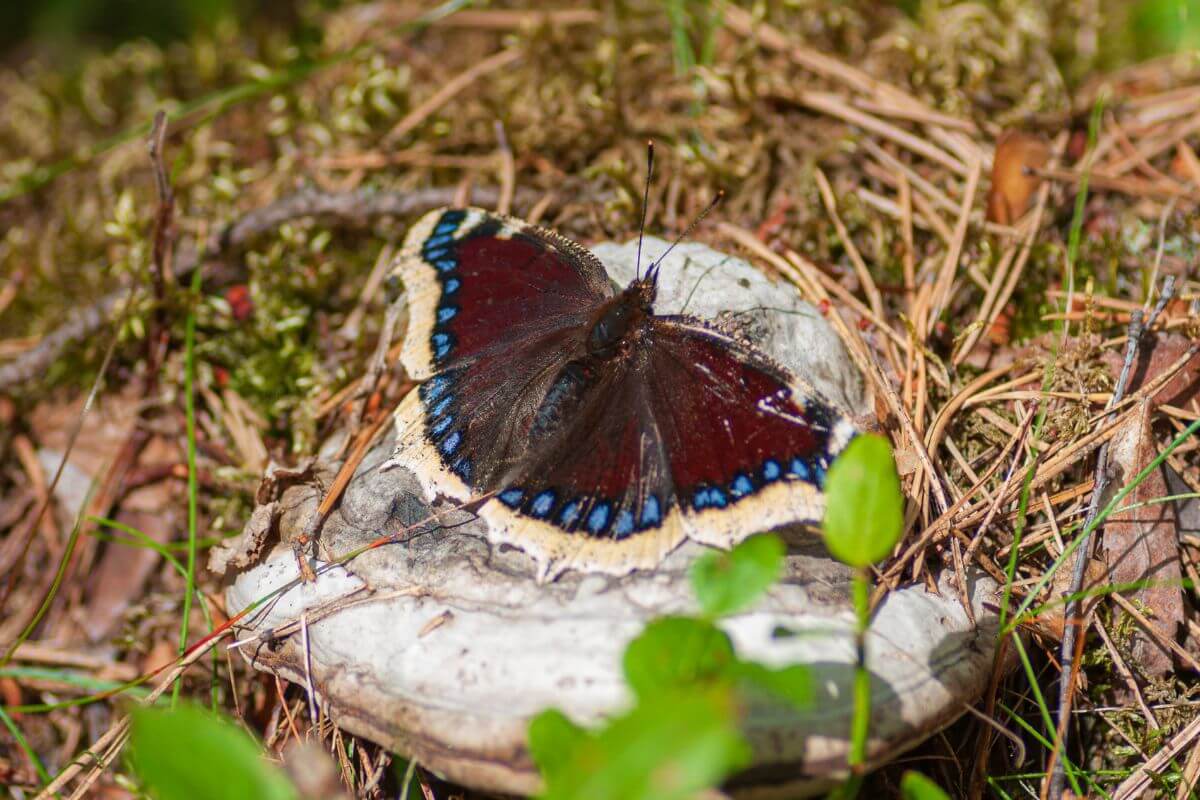
Finding love can be quite the adventure for the mourning cloak butterfly, Montana’s official state insect.
These fascinating creatures engage in a unique mating behavior known as lekking, where males gather in a specific area, known as a lek site, to perform courtship displays in hopes of attracting the attention of receptive females.
During lekking, male mourning cloak butterflies congregate on tree trunks, using their wings to capture the attention of the receptive females.
They showcase their wing-flapping prowess, displaying their physical traits such as their beautiful dark brown wings with blue spots and shimmering purple highlights.
These physical attributes play a crucial role in the selection process, as females are known to prefer males with larger wingspans and more vibrant colorations.
These preferences not only ensure genetic diversity but also help ensure the survival of the species. It is fascinating to think about the lengths these butterflies go through to find their perfect match.
From lekking and attention-grabbing courtship displays to the intricate dance of copulation, the mourning cloak butterfly’s mating behaviors provide a captivating glimpse into the world of these beautiful insects.
2. Mourning Cloak Butterfly Reproduction
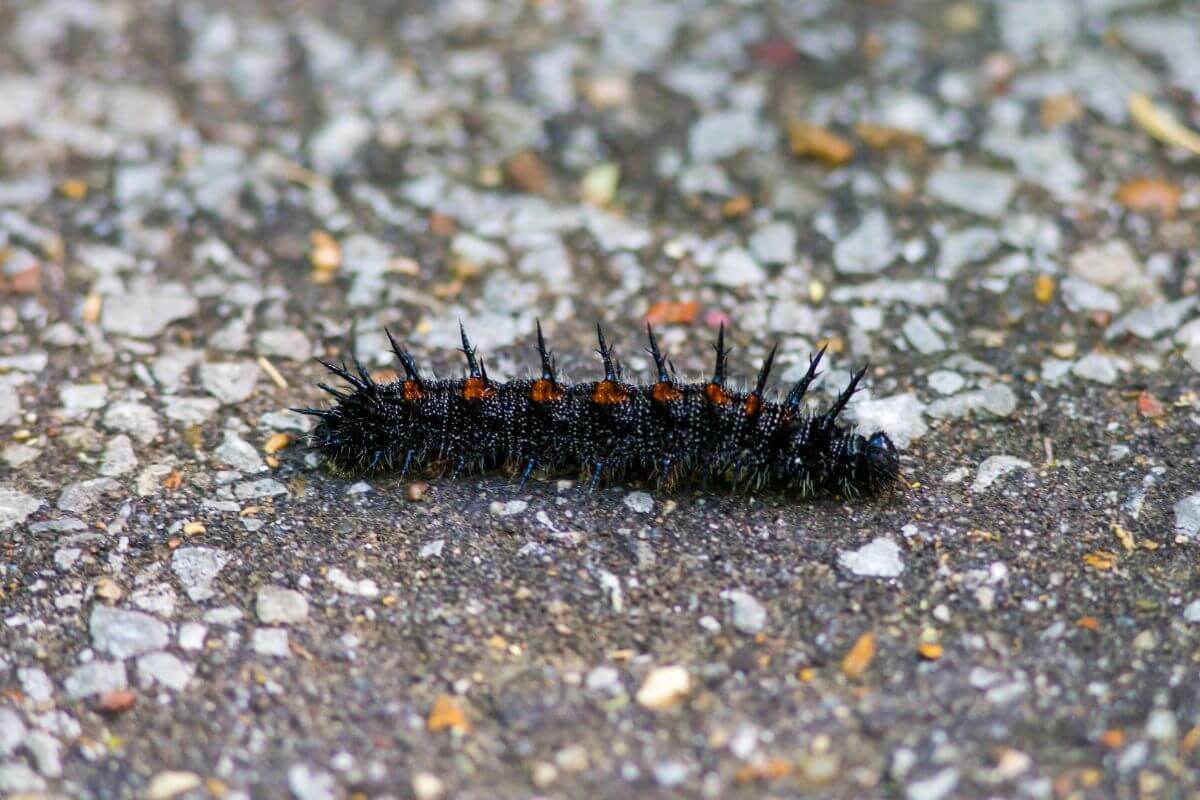
As the official state insect of Montana, the mourning cloak butterfly is a beautiful and fascinating creature. And when it comes to reproduction, these butterflies have a unique and captivating process.
Males rely on their keen sense of sight to locate receptive females. Once a potential mate is spotted, the male initiates courtship displays to attract her.
During this elaborate display, the males showcase their fluttering wings, adorned with dark brown hues and shimmering blue spots to females.
The males compete fervently, performing their wing-flapping dance intricately, vying for the attention and affection of the females.
Once a female mourning cloak butterfly selects her mate, the two butterflies position themselves side by side, with their abdomens touching, facing away from each other.
The actual act of copulation lasts anywhere from 30 minutes to an hour and varies from couple to couple. During this process, the male releases pheromones to strengthen the bond between them.
This intricate process of courtship and copulation is a stunning display of nature’s creativity and the marvels that Montana’s state insect, the mourning cloak butterfly, has to offer.
3. Mourning Cloak Butterfly Life Cycle
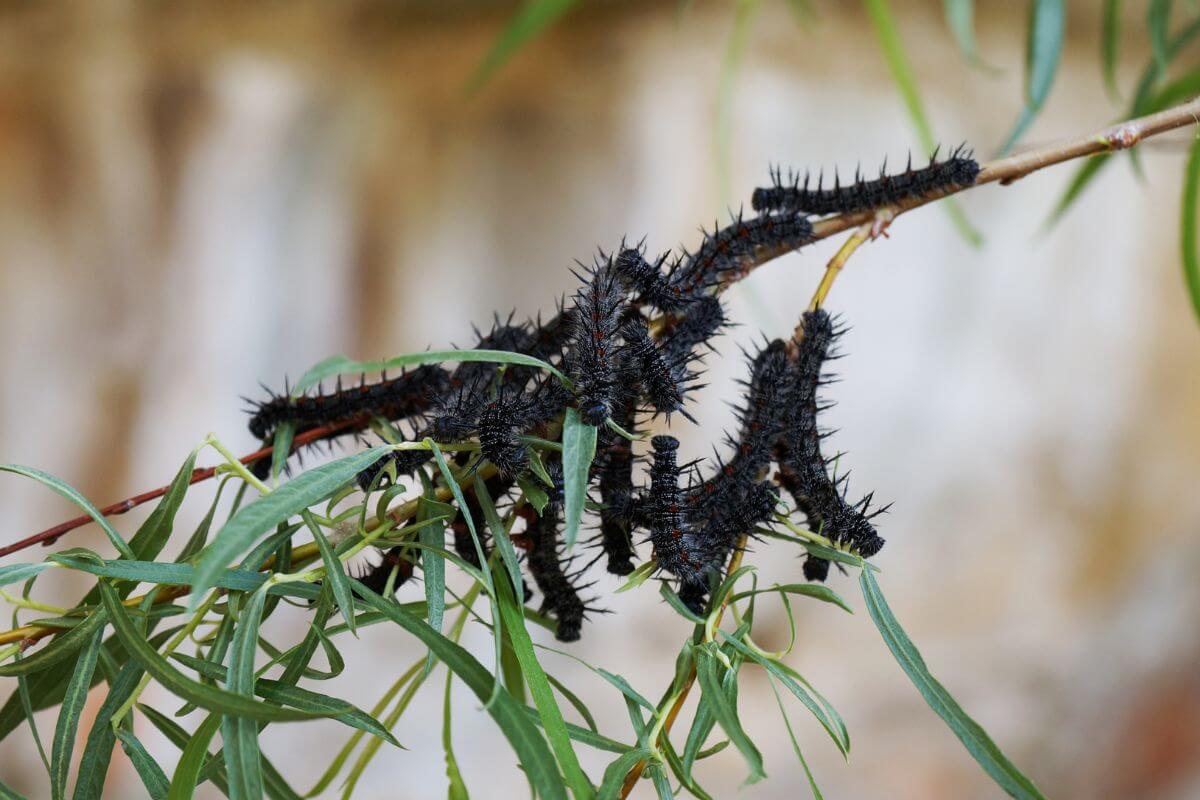
The life cycle of the mourning cloak butterfly is a fascinating journey filled with transformation and renewal.
From the moment they emerge as adults, these beautiful insects embark on a remarkable adventure that spans months, showcasing the wonders of nature.
Once mourning cloak butterflies have found their mates and completed their courtship rituals, their lives take a bittersweet turn. They know their time is limited, yet they make the most of it.
These butterflies, often referred to as “adult mourning cloaks,” have the ability to live up to 10 months, a long lifespan for their kind.
As the end of their lives draws near, female mourning cloak butterflies lay their eggs in single-layer clusters, encircling the tips of host plant twigs.
These eggs, usually numbering up to 250, are carefully placed, rarely on leaves, ensuring the survival of the next generation.
In just a matter of 5-10 days, these miraculous eggs hatch into tiny caterpillars.
Their velvety black bodies adorned with raised white dots and rows of striking red spots and spines down their backs can grow up to 2 inches long.
During the caterpillar stage, mourning cloak caterpillars tirelessly eat and grow, shedding their skin several times as they nourish themselves on host plants such as willows and cottonwoods.
Their distinctive spines and hairs protect them from predators, allowing them to feed in obvious groups.
Once these fuzzy caterpillars have reached maturity, they leave the safety of their feeding grounds and embark on a new adventure.
They seek the perfect spot to transform themselves into pupae. Encased in a gray chrysalis, adorned with spikes and a promise of change, they undergo the miraculous process of metamorphosis.
Within a span of 10-15 days, depending on the temperature, the transformation is complete and a magnificent new mourning cloak butterfly emerges from the chrysalis, ready to take flight and continue the circle of life.
These adult butterflies, with their dark wings and mesmerizing blue spots, will go on to play their vital role in pollination and the preservation of their species.
The life cycle of the mourning cloak butterfly is a testament to the beauty and resilience of nature.
From the delicate eggs on host plants to the vibrant adult butterflies gracing our landscapes, each stage holds its own unique significance and adds to the tapestry of life in the natural world.
Mourning Cloak Butterfly Food
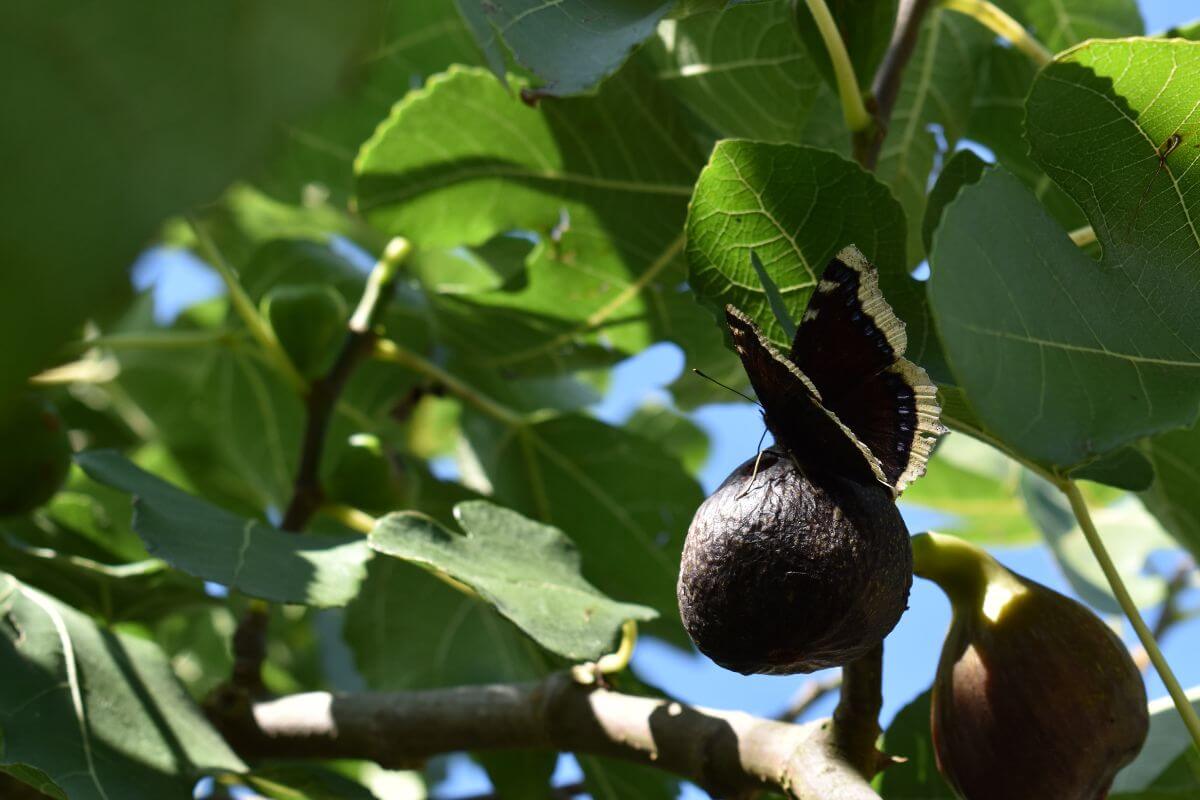
The mourning cloak butterfly has a unique diet that changes as it ages through different stages of its life cycle. During its adult stage, the mourning cloak butterfly relies on a rather unconventional food source – tree sap.
It has a remarkable ability to tap into sap flows by piercing the bark with its proboscis-like mouthparts and drinking up the sweet liquid.
This behavior is especially evident in late winter or early spring when the butterfly emerges from its chrysalis. It seeks out deciduous trees like maples and oaks which are known to have abundant sap flows.
They will also feed on rotting fruit, and only occasionally on flower nectar.
On the other hand, the caterpillars of the mourning cloak butterfly have their own set of preferred food sources. They primarily feed on the leaves of black willow, silky willow, and hackberry bushes.
Its ability to adapt its food sources throughout its life stages is a testament to its resilience and survival skills.
In conclusion, the mourning cloak butterfly has a diverse diet that includes tree sap, leaves of specific host plants, and even fruit.
Speaking of fruits, while you’re on your nature walk with these butterflies, you might be interested to know more about the huckleberry, Montana’s symbolic fruit.
Who knows, you might also encounter this one-of-a-kind fruit alongside your exploration.
Mourning Cloak Butterfly Defense
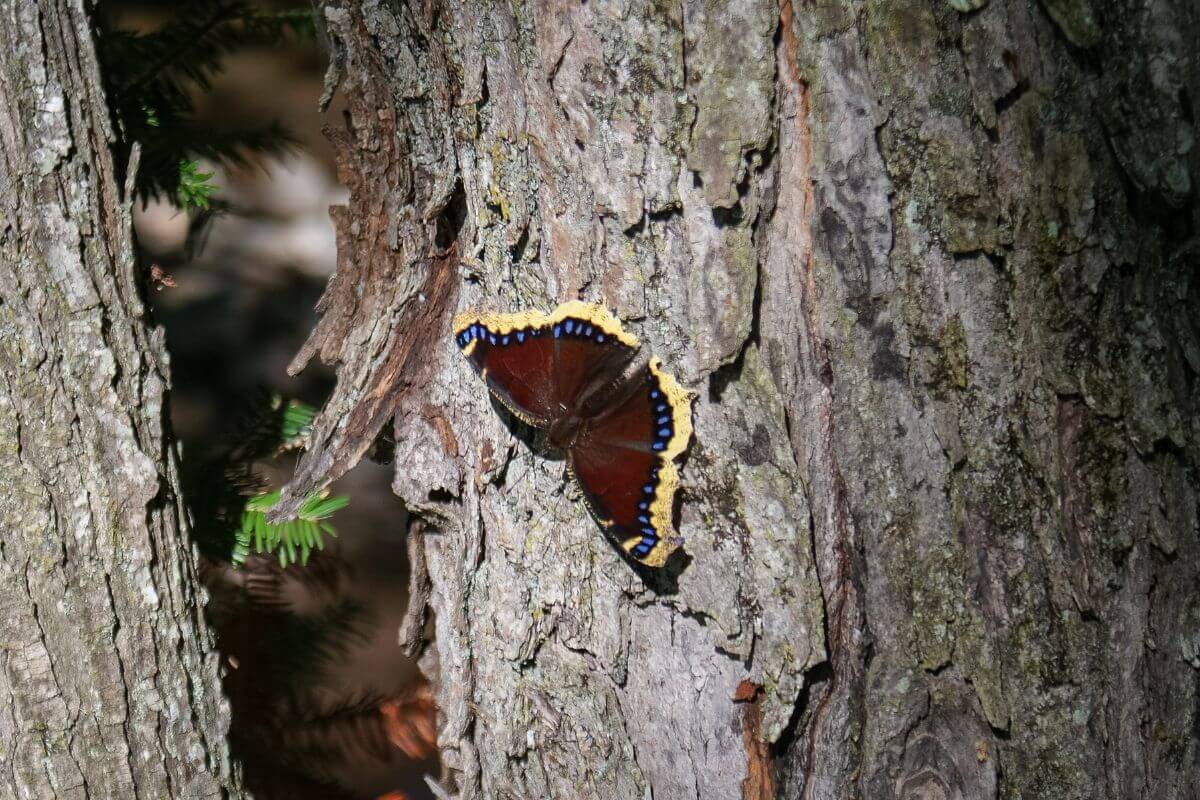
Camouflage is a cunning tool in the arsenal of the mourning cloak butterfly.
Its dark brown wings, adorned with delicate blue spots and shimmering purple highlights, blend seamlessly with the tree trunks they call home.
But when danger looms, these remarkable insects take it a step further. They join forces with other butterflies, flying together, as if to say, “We are not an easy target.”
But that’s not all. When confronted by an attacker, mourning cloaks have a trick up their wings. With a swift motion, they close their wings, play dead, and reveal a subtle beige border and a striking yellow border.
Motionless and seemingly lifeless, they produce loud clicking sounds, a chilling ruse that deters even the boldest predators.
Mourning cloak butterflies have a knack for staying warm which plays a big part in their survival. They seek out spots with direct sunlight, spreading their dark wings to absorb every ray of heat.
It’s nature’s own defense mechanism, ensuring they remain active even in the face of biting cold.
Interestingly, even the newly hatched caterpillars of the mourning cloak butterfly display remarkable survival tactics.
In their determination to thrive, mourning cloak caterpillars may resort to the unthinkable. They devour the unhatched eggs of their own siblings, a true testament to the lengths they will go to ensure their survival.
Not to be outdone, the larvae and pupae of the mourning cloak butterfly have their own ingenious defense strategy.
When they sense a disturbance, they move in perfect unison, maximizing their impact and appearing larger than they really are.
It’s a sight to behold, as they dance together, a synchronized display of survival.
Montana State Insect Final Thoughts
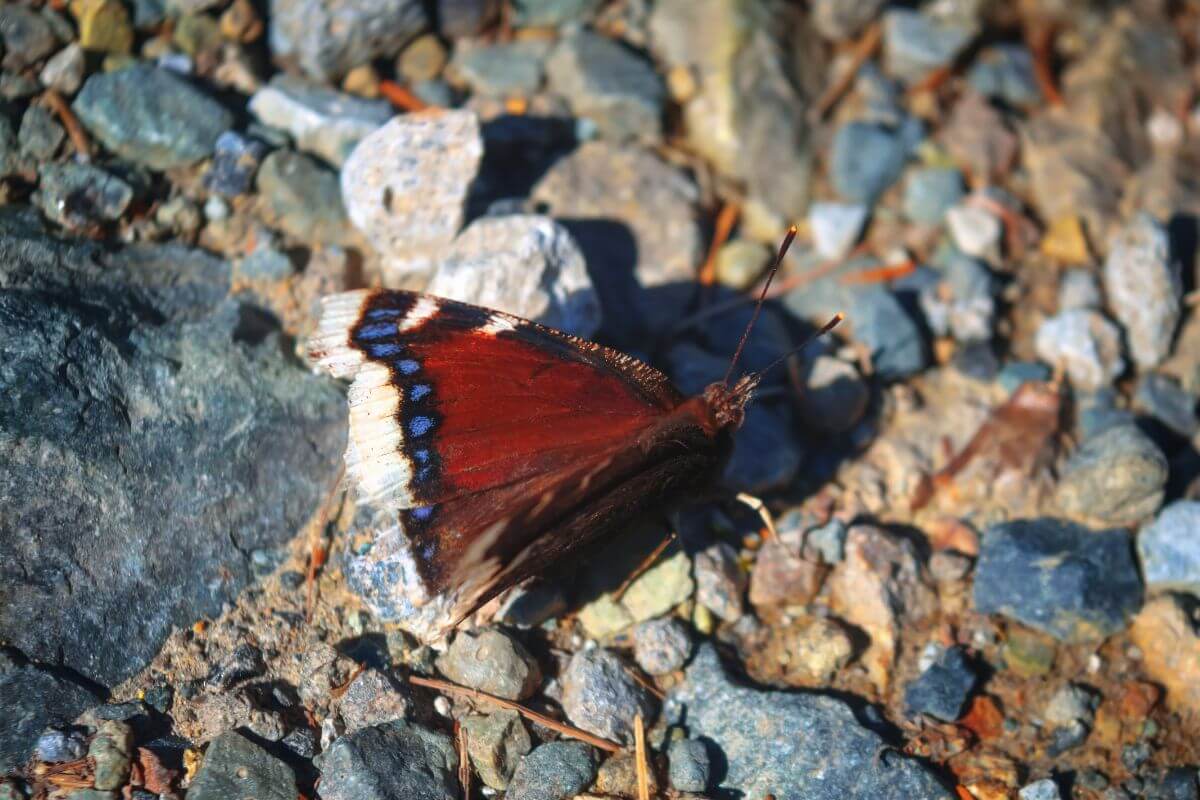
Montana’s official state insect, the mourning cloak butterfly is not only visually pleasing with its dark brown wings but it also has an array of defense mechanisms that have earned it a rightful place in the hearts of Montanans.
Seeking out sunny spots, it spreads its dark wings to absorb every ray of heat, defying the biting cold of icy winters with its natural warmth.
And if that wasn’t impressive enough, even its newly hatched caterpillars display remarkable survival tactics by seeking out their own sources of food.
In a move as unthinkable as it is resourceful, they devour the unhatched eggs of their own siblings, a true testament to their determination to thrive.
But the marvels of the mourning cloak butterfly do not end there. Its defense mechanisms are as cunning as they are captivating.
From blending seamlessly with the tree trunks they call home to flying in groups, these butterflies display remarkable adaptability.
The mourning cloak butterfly is more than just a beautiful insect; it is a symbol of resilience, representing the triumph of survival in the face of adversity.
Montana made the perfect choice in designating it as the state insect, a fitting tribute to the awe-inspiring appearance, behavior, and impact of this remarkable creature.
Montana State Insect FAQs
1. Is the Mourning Cloak Butterfly Rare in Montana?
The mourning cloak butterfly, scientifically known as Nymphalis antiopa, is native to the Northern Hemisphere and can be found in various parts of Europe, Asia, and North America.
The mourning cloak butterfly is actually a rather widespread and abundant creature in Montana.
2. Where Did the Mourning Cloak Butterfly Get Its Name?
The mourning cloak butterfly’s name bears a striking resemblance to a traditional dark-colored cloak that one might wear while in mourning.
The butterfly’s wings possess a mesmerizing dark brown coloration, evoking a sense of mournfulness and solemnity. This characteristic has inspired its name throughout history.
3. What Is a Common Butterfly in Montana?
What is the most common butterfly in Montana, you ask? Well, let me introduce you to the charming Red Admiral, known by its scientific name, Vanessa atalanta.
This delightful creature holds a special place within Montana’s diverse ecosystem. Its striking appearance is characterized by a velvety black color, adorned with splashes of vibrant orange and white.
4. What Is Montana’s State Insect?
Montana’s state insect is the Mourning Cloak Butterfly, scientifically known as Nymphalis antiopa. It can be found in various parts of Europe, Asia, and North America, but it has a special place in the hearts of Montanans.
5. What Color Is a Mourning Cloak Butterfly?
The mourning cloak butterfly is easily recognized by its striking dark red or brown color with bright blue spots near the yellow margins of its wings.
Enchanted by how wonderful Montana is yet? Well, here’s a list of awesome articles that you can read:
- Montana’s Official Prehistoric Symbol
- Montana Official Grass
- Montana’s Official Lullaby
- Montana’s Official Motto
- http://www.wci.colostate.edu/Assets/pdf/CIIFactSheets/MourningCloak.pdf
- https://uwm.edu/field-station/mourning-cloak-revisited/
- https://fieldguide.mt.gov/speciesDetail.aspx?elcode=IILEPK6030
- https://www.montana.edu/yellowstoneinsects/lepidoptera/nymphalidae/vanessa_cardui.html
- https://butterfly.ucdavis.edu/butterfly/nymphalis/antiopa
- https://butterfly.ucdavis.edu/butterfly/vanessa/atalanta
- https://commons.wikimedia.org/wiki/File:Nymphalis_antiopa_02.JPG
- https://commons.wikimedia.org/wiki/File:Mourning_cloak_caterpillar_(17460762818).jpg

